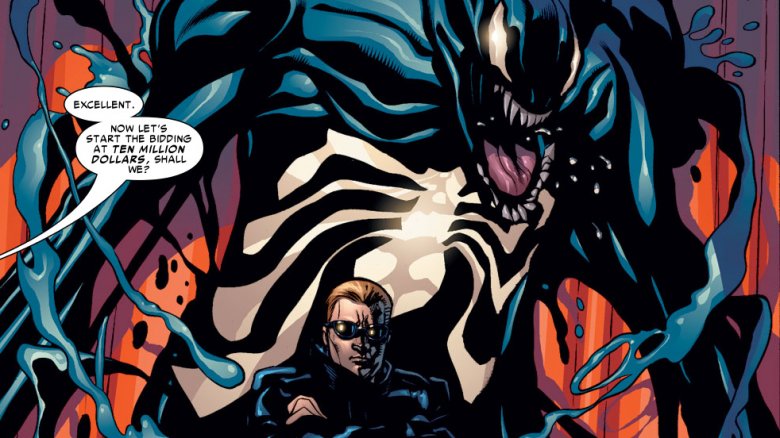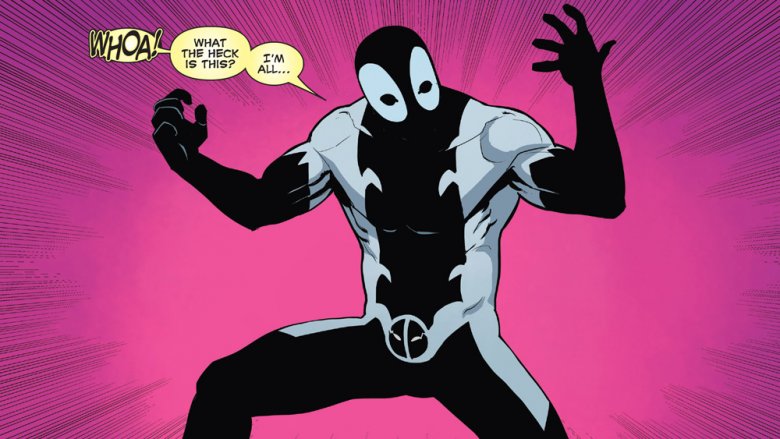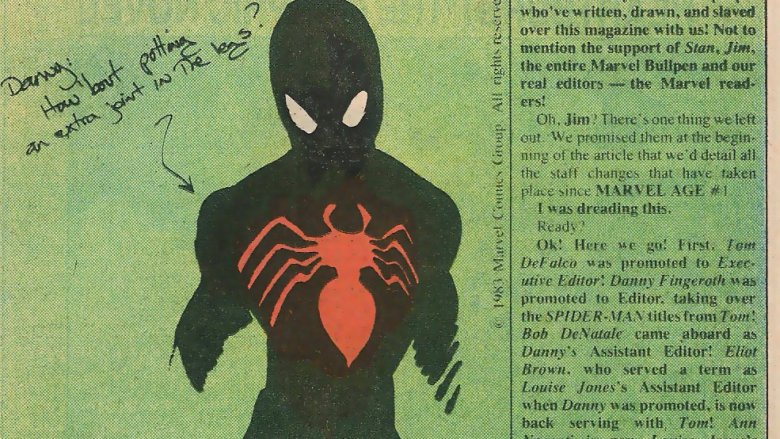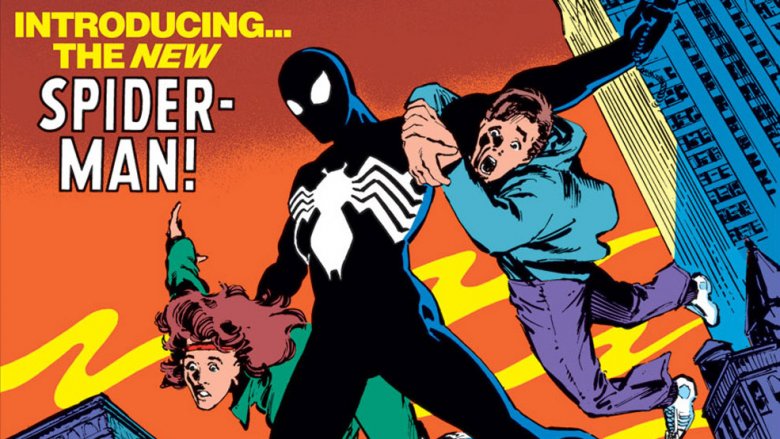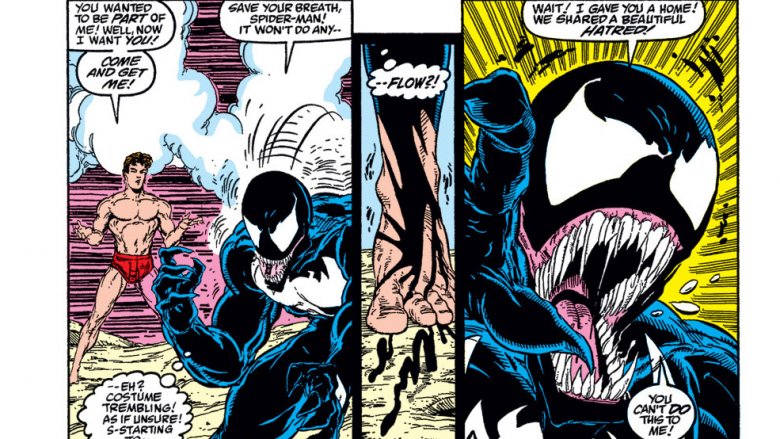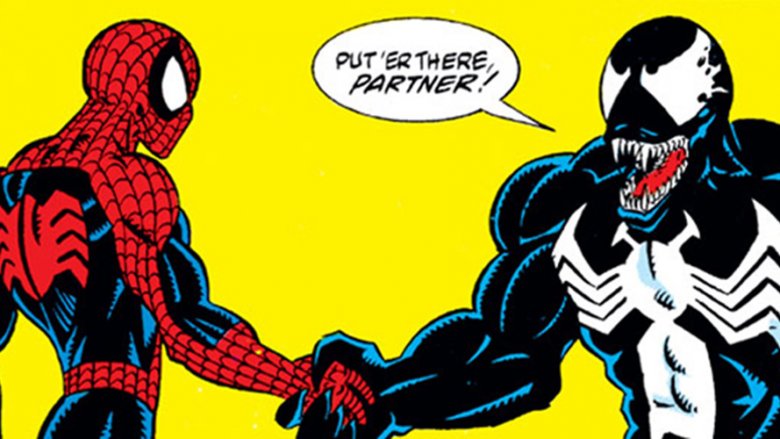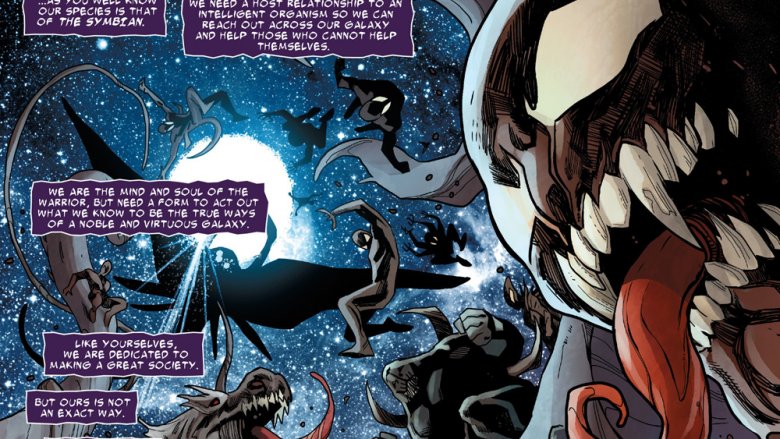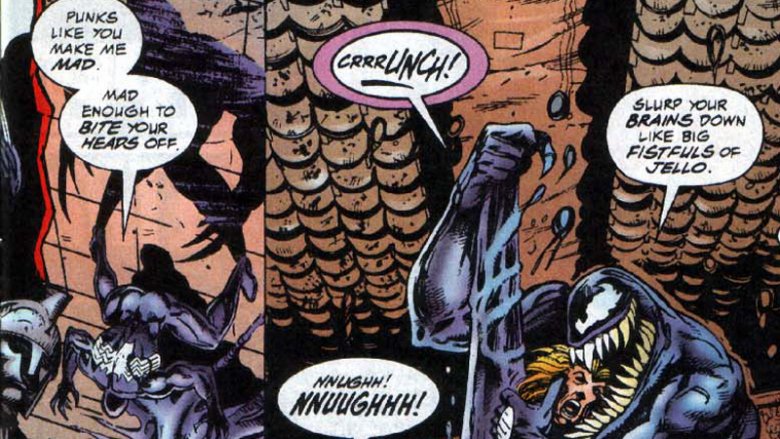False Facts About Venom You Thought Were True
To say Venom is popular is putting it mildly. After debuting as a new costume for Spider-Man that quite literally took on a life of its own, the symbiotic alien that we'd come to know as Venom quickly became one of the most beloved members of Spider-Man's extensive gallery of foes, and as a ruthless "lethal protector," he even became a hero in his own right.
But like most popular characters, he's starred in enough stories to turn his relatively simple origin as a brain-eating alien costume into a pretty complicated series of backstories, retcons, and even identity changes. With all that behind him over the past three decades, there's a good chance you might think you know something about Venom that turns out to be completely and utterly false. From his not-so-secret identity on Earth to the depths of space, and all the way to his unusual diet, here are things about Venom you might've thought were true.
Eddie Brock: the one and only?
When Venom made his (their?) debut in 1988, it was as the synthesis of two characters brought together to form the ultimate Spider-Man villain. One half, of course, was the alien symbiote that had formerly served as the web-slinger's costume before Peter Parker realized that his new pants had a mind of their own, and the other was disgraced journalist Eddie Brock, who nurtured an intense hatred for Spider-Man all his own. In the years since, Brock has been synonymous with Venom, but if you've been under the impression that he was the only villain to use that name, you're very mistaken.
While Brock was the original and current Venom, he's far from the only one. In 2004, when he found religion after seeing The Passion of the Christ, Brock auctioned off the symbiote costume to a new host. It was originally purchased for $100 million by Angelo Fortunato, the teenage son of a mob boss who wanted to impress his father and become famous enough that girls would write fan fiction about him. No, really; all that happened in Marvel Knights Spider-Man #6 and 7, if you want to look it up for yourself.
Unfortunately for Angelo, his tenure as Venom only lasted a single issue, but the symbiote stuck around. Next it bonded to Mac Gargan, the Spider-Foe previously known as the Scorpion, who even used it to become the fake Spider-Man on Norman Osborn's team of Dark Avengers. After that, it was confiscated by the government and given to Peter Parker's former high school bully and decorated war hero Flash Thompson to use as a one-man commando unit called Agent Venom. Eventually, though, it made its way back to Brock permanently ... for now.
Anger issues
One of the symbiote's most notable properties is its tendency to amplify its hosts' anger, especially where Spider-Man is concerned. With its all-consuming anger, it's easy to imagine that the symbiote is naturally aggressive, and its presence will inevitably drive its host to a raging madness.
According to Venom: Space Knight, however, that's not the case. It's actually the other way around: The symbiote was pretty chill and maybe even a little noble when it encountered its very first host, a Kree warrior named Tel-Kar, who used its powers to become a sleeper agent. Unfortunately, the symbiote's next host, the first one the symbiote remembers, was a genocidal maniac who wound up using its power to slaughter his entire world. It was the host that influenced the symbiote, traumatizing and twisting it into the villainous mindset it still has today.
Fortunately, the fact that the host can influence the symbiote works in the good guys' favor, too. As you might've heard, Peter Parker takes power and responsibility pretty seriously, and it seems that may have rubbed off on the symbiote and set it on its path to being less of a full-on bad guy and a little more of an antihero.
First things first?
Eddie Brock was the original Venom, but before he bonded with the alien symbiote, its first victim-host was Spider-Man. He was absolutely, unequivocally the first Marvel Superhero to bond with the black costume, right?
Well, yes and no. If you're talking about our real-world timeline, then yes, that's exactly how it works. If, however, you want to dive into the actual canon of the Marvel Universe, things are a little more complicated, as they usually are. It turns out that the first hero to discover the alien costume and even to wear it was ... Deadpool? Yep, and if you're wondering how that happened when the symbiote's first appearance in Secret Wars happened six years before Deadpool was created, it's all thanks to the magic of retcons.
In 2015's Deadpool's Secret Secret Wars, it was "revealed" that the Merc with a Mouth actually tagged along with the rest of the heroes recruited to fight in the Beyonder's live-action toybox. During the conflict, he was the first one to try on the Symbiote thinking it was a new set of clothes, but removed it after realizing it was alive and he couldn't subject it to the pain of bonding with his own twisted thoughts. Instead, he put it back in its containment unit, and then made sure to let Spider-Man know where he could find a new costume as he left the room.
The secret origin of the Black Costume
Speaking of Secret Wars, it's obvious that the black costume that would become Venom was created for the event. After all, every Marvel title that saw their lead characters heading off to Battleworld had them coming home with some huge change, including a new lineup in the pages of Fantastic Four. For Spider-Man, it seems clear that the hook to the crossover was a new costume created just for the event. But the real answer is not quite that obvious.
Instead, the origins of the black costume come two years before Secret Wars, when a fan named Randy Schueller wrote Marvel with an idea for a story where Spider-Man would get a new black costume. In his idea, the new costume would be a high-tech update of his old one created by Mr. Fantastic and designed by the Wasp. Jim Shooter, editor in chief of Marvel, liked the idea enough to pay Schueller $220 for it, but the proposed story never happened. Instead, Marvel kept Schueller's idea on the back burner until they found a place to use it, and that place was Secret Wars.
While it wound up being the product of a completely different story and involved a completely different origin, the black costume was clearly based on Schueller's pitch. The only difference is that he'd originally pitched it as being black with a red logo, while the final product had a white insignia. Early designs in the pages of Marvel Age, however, show that the suit was originally intended to have Schueller's suggested color scheme before it was changed for the final version.
Debuting in Secret Wars
For Venom fans, Secret Wars #8 will always hold a hallowed place in the annals of symbiote history. That's the issue where Spider-Man, in search of a new costume, accidentally unleashes the symbiote and bonds with it, kicking off 35 years of brain-eating fun.
That's not the costume's first appearance, though. Since Secret Wars was the first company-wide superhero crossover ever, Marvel wanted every reader they had to pick it up, and seeded the massive changes that the big event would bring in the pages of their ongoing comics. One month, the characters were whisked off to Battleworld, but they all returned in the next issue, speaking in very vague terms about the adventures they'd had in the pages of a comic that hadn't actually come out yet. While Secret Wars #8 would explain how Spider-Man got his new costume, he'd been wearing it for months, ever since Amazing Spider-Man #252.
In fact, in a weird quirk of storytelling, the entire saga of Spider-Man's first brush with the symbiote happened in Amazing Spider-Man before its origin story was published. By the time Secret Wars showed him getting his new suit, he had already discovered it was alive, had it blasted off by Reed Richards of the Fantastic Four, and made an ill-fated journey back to his apartment using a paper bag to conceal his identity.
A love/hate relationship
One thing that can't be disputed about the Venom symbiote is that it has a deep and all-consuming hatred for Spider-Man. What other emotion could lead it to battle him so many times over the years? Well, there is one other emotion that occasionally leads to that kind of obsession and conflict. As we all know, there's a thin line between hate and love.
While Eddie Brock might've hated Peter Parker's guts without much room for argument, the symbiote's relationship to Spider-Man was a little more complicated. Rather than just wanting to keep feeding on him as a host, the symbiote seemed to have a sort of affection for Spidey. When it tried to bond with him a second time, after Spider-Man subjected it to a devastating sonic attack in the form of a clanging church bell, the symbiote risked its own "life" to rescue Peter from being killed by the sounds as well.
Even more compelling was the conflict that came in Amazing Spider-Man #317. In a battle that went way past subtext, Peter was able to defeat Venom by, no joke, stripping down to his underwear on the beach and offering up his body to the alien costume while shouting things like "You want me? Then take me -— I'm yours!" It worked, too: Rather than sticking with its rebound, Eddie Brock, the symbiote fell for Spidey's sym-booty call and knocked itself out trying to sever its connection to its current host. Who knew Venom was a villain who could be defeated by a "u up?" text?
Permanent isn't so permanent anymore
When Spider-Man first became aware that his new costume had a mind of its own, it took all his strength and the intervention of the Fantastic Four to get him out of it. The second time it tried to bond with him, he risked his life trying to break the connection. When they fought on that beach, the trauma of trying to separate from Brock was so great that it knocked everyone out and left Eddie virtually comatose long enough for him to be scooped up by the authorities and sent to the Raft. Clearly, once the costume has its hooks in you, it's nearly impossible to get rid of it.
Unless, of course, it decides to bail on its own. While bonding with the black costume is usually a pretty lasting situation, that's not always the case. During Flash Thompson's tenure as Agent Venom, he was initially limited to a maximum of 48 hours bonded with the symbiote, in order to minimize the risk of the costume taking over his mind. At the end of every mission, he'd be blasted with high-frequency sonics to drive the costume off him, although the procedure was not without its complications.
There was, however, a much simpler example of the symbiote ditching its host. The reason that Angelo Fortunato only lasted a single issue as Venom was the symbiote rejected him — about ten stories off the ground. When Angelo ran away from a fight with Spider-Man, the symbiote decided he was too much of a coward to be Venom. Since he wasn't cut out for the job, the symbiote bailed, leaving Angelo to fall to his death.
Best frenemies
Whether motivated by love or hate, Venom is decidedly an enemy for Spider-Man ... except when he's not, that is. While he was definitely originally introduced as an antagonist for the web-slinger, his overwhelming popularity with fans led to a slightly different path.
Aside from his original handful of appearances, the majority of Venom's most prominent moments involved him fighting for the good guys ... more or less. One of the biggest Spider-Man stories of the '90s, Maximum Carnage, saw Spider-Man and Venom teaming up to stop a cadre of villains led by someone they both hated, a second symbiote named Carnage that bonded with a serial killer named Cletus Kasady.
Even more recently, the two characters teamed up again, and this time, it was far from an uneasy alliance. Instead, when Norman Osborn bonded with the Carnage symbiote to become the Red Goblin — and threatened to murder Spider-Man's entire supporting cast — Eddie Brock even went as far as "loaning" the symbiote costume to Peter Parker in order to give him the edge he needed to win the fight and save his friends and family. Although there's been a conflict between them for decades, and almost certainly will be again, that's a level of trust between them that goes well beyond the simple dynamic of enemies.
One in a thousand?
If there's one thing we all know about Venom, it's that he's completely unique in the Marvel Universe. It's one of the reasons he's so popular — there's no other character like him! Uh, except Carnage, of course, who was split off from Venom to become an even worse villain. And the other six symbiote "children" we've seen in the comics over the past 30 years. And Anti-Venom, who's really just Venom with the colors swapped around. Beyond that, though, there's nothing quite like this particular symbiote, right?
Well, that one was true until 2015, when it was revealed in the pages of Guardians of the Galaxy that Venom is actually a member of an alien race called the Klyntar, and that there are plenty of symbiotes out there that go beyond the ones that have been encountered on the Earth of the Marvel Universe. The one we know as Venom is actually the 998th generation, so there are at least a thousand others out there somewhere, just waiting for a spidery hero to pop up during the next Secret War and give them a lift home.
I wanna eat your brains!
One of the long-running jokes about Venom is that he eats brains, a fact so ridiculous that it even showed up in the kid-friendly "Bullpen Bits" comics that used to run in Marvel Comics. In reality, though ... well, actually, this one's completely true. Venom does really eat brains. It's just probably not for the reason you think.
The first time Venom snacked on someone's grey matter was in Len Kaminski and Ted Halsted's Venom: The Hunger #1, from 1996. In that comic, after threatening to eat the brains of a few criminals, Eddie Brock found that the regular food he was eating tasted "like sewage" and returned to the crooks to actually go through with it. He was understandably horrified by what he'd done once he came to his senses, but the whole brain-eating thing wasn't just cannibalism or Venom joining the ranks of the walking dead. Instead, it turned out to be a necessary craving for a chemical that existed in the human brain. Fortunately, Eddie was able to control those cravings when he discovered that the same chemical existed in chocolate, leading him to load up on candy bars rather than cracking open bad guys' skulls.
Here's the best part, though: That's not just goofy comic book science. The chemical phenethylamine is a 100 percent real neurotransmitter that exists in the central nervous system and in chocolate, with mood-elevating properties that are one of the reasons that most of us feel a little better after we eat a candy bar. It's a good reason to keep a Snickers on hand, just in case you run into any evil alien parasites out there.

